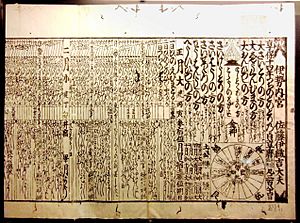Jōkyō calendar facts for kids
The Jōkyō calendar (also known as Teikyō-reki) was a special calendar used in Japan. It was a type of lunisolar calendar, which means it used both the Moon's phases and the Sun's position to keep track of time. This calendar was used for many years, from 1684 to 1753. It became the official calendar of Japan in 1685.
Why a New Calendar Was Needed
For a very long time, Japan used a calendar that came from China. This calendar, called the Semmyō calendar, had been used for about 800 years! But over such a long time, small mistakes added up. The calendar was no longer perfectly matching the seasons.
Shibukawa Shunkai's Discovery
A smart Japanese astronomer named Shibukawa Shunkai noticed these problems. He studied the sky very carefully. He figured out that the length of a solar year (the time it takes for Earth to go around the Sun) was actually 365.2417 days. This was a very accurate measurement for his time.
Because of his important discovery, the old Semmyō calendar was replaced. The Jōkyō calendar was created based on Shibukawa Shunkai's new calculations. This made sure that festivals and farming seasons would happen at the correct times of the year.
Related pages
- National Diet Library, "The Japanese Calendar"


